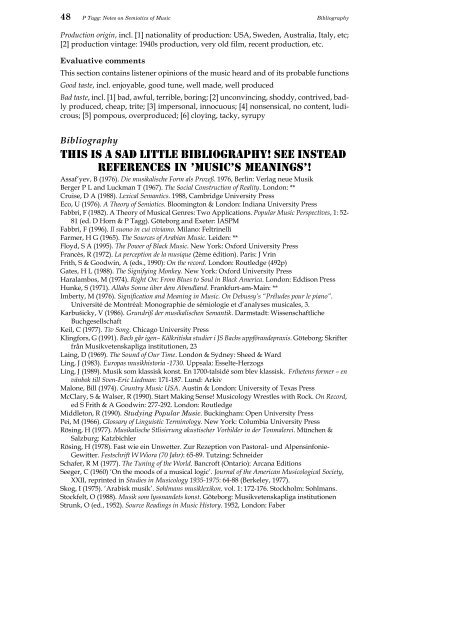Introductory notes to the Semiotics of Music - Philip Tagg's home page
Introductory notes to the Semiotics of Music - Philip Tagg's home page
Introductory notes to the Semiotics of Music - Philip Tagg's home page
Create successful ePaper yourself
Turn your PDF publications into a flip-book with our unique Google optimized e-Paper software.
48 P Tagg: Notes on <strong>Semiotics</strong> <strong>of</strong> <strong>Music</strong> Bibliography<br />
Production origin, incl. [1] nationality <strong>of</strong> production: USA, Sweden, Australia, Italy, etc;<br />
[2] production vintage: 1940s production, very old film, recent production, etc.<br />
Evaluative comments<br />
This section contains listener opinions <strong>of</strong> <strong>the</strong> music heard and <strong>of</strong> its probable functions<br />
Good taste, incl. enjoyable, good tune, well made, well produced<br />
Bad taste, incl. [1] bad, awful, terrible, boring; [2] unconvincing, shoddy, contrived, badly<br />
produced, cheap, trite; [3] impersonal, innocuous; [4] nonsensical, no content, ludicrous;<br />
[5] pompous, overproduced; [6] cloying, tacky, syrupy<br />
Bibliography<br />
THIS IS A SAD LITTLE BIBLIOGRAPHY! SEE instead<br />
references in ’<strong>Music</strong>’s Meanings’!<br />
Assaf’yev, B (1976). Die musikalische Form als Prozeß. 1976, Berlin: Verlag neue Musik<br />
Berger P L and Luckman T (1967). The Social Construction <strong>of</strong> Reality. London: **<br />
Cruise, D A (1988). Lexical Semantics. 1988, Cambridge University Press<br />
Eco, U (1976). A Theory <strong>of</strong> <strong>Semiotics</strong>. Blooming<strong>to</strong>n & London: Indiana University Press<br />
Fabbri, F (1982). A Theory <strong>of</strong> <strong>Music</strong>al Genres: Two Applications. Popular <strong>Music</strong> Perspectives, 1: 52-<br />
81 (ed. D Horn & P Tagg). Göteborg and Exeter: IASPM<br />
Fabbri, F (1996). Il suono in cui viviamo. Milano: Feltrinelli<br />
Farmer, H G (1965). The Sources <strong>of</strong> Arabian <strong>Music</strong>. Leiden: **<br />
Floyd, S A (1995). The Power <strong>of</strong> Black <strong>Music</strong>. New York: Oxford University Press<br />
Francès, R (1972). La perception de la musique (2ème édition). Paris: J Vrin<br />
Frith, S & Goodwin, A (eds., 1990): On <strong>the</strong> record. London: Routledge (492p)<br />
Gates, H L (1988). The Signifying Monkey. New York: Oxford University Press<br />
Haralambos, M (1974). Right On: From Blues <strong>to</strong> Soul in Black America. London: Eddison Press<br />
Hunke, S (1971). Allahs Sonne über dem Abendland. Frankfurt-am-Main: **<br />
Imberty, M (1976). Signification and Meaning in <strong>Music</strong>. On Debussy’s “Préludes pour le piano”.<br />
Université de Montréal: Monographie de sémiologie et d’analyses musicales, 3.<br />
Karbušicky, V (1986). Grundriß der musikalischen Semantik. Darmstadt: Wissenschaftliche<br />
Buchgesellschaft<br />
Keil, C (1977). Tiv Song. Chicago University Press<br />
Klingfors, G (1991). Bach går igen– Kälkritiska studier i JS Bachs uppförandepraxis. Göteborg: Skrifter<br />
från Musikvetenskapliga institutionen, 23<br />
Laing, D (1969). The Sound <strong>of</strong> Our Time. London & Sydney: Sheed & Ward<br />
Ling, J (1983). Europas musikhis<strong>to</strong>ria -1730. Uppsala: Esselte-Herzogs<br />
Ling, J (1989). Musik som klassisk konst. En 1700-talsidé som blev klassisk. Frihetens former – en<br />
vänbok till Sven-Eric Liedman: 171-187. Lund: Arkiv<br />
Malone, Bill (1974). Country <strong>Music</strong> USA. Austin & London: University <strong>of</strong> Texas Press<br />
McClary, S & Walser, R (1990). Start Making Sense! <strong>Music</strong>ology Wrestles with Rock. On Record,<br />
ed S Frith & A Goodwin: 277-292. London: Routledge<br />
Middle<strong>to</strong>n, R (1990). Studying Popular <strong>Music</strong>. Buckingham: Open University Press<br />
Pei, M (1966). Glossary <strong>of</strong> Linguistic Terminology. New York: Columbia University Press<br />
Rösing, H (1977). Musikalische Stlisierung akustischer Vorbilder in der Tonmalerei. München &<br />
Salzburg: Katzbichler<br />
Rösing, H (1978). Fast wie ein Unwetter. Zur Rezeption von Pas<strong>to</strong>ral- und Alpensinfonie-<br />
Gewitter. Festschrift W Wiora (70 Jahr): 65-89. Tutzing: Schneider<br />
Schafer, R M (1977). The Tuning <strong>of</strong> <strong>the</strong> World. Bancr<strong>of</strong>t (Ontario): Arcana Editions<br />
Seeger, C (1960) ‘On <strong>the</strong> moods <strong>of</strong> a musical logic’. Journal <strong>of</strong> <strong>the</strong> American <strong>Music</strong>ological Society,<br />
XXII, reprinted in Studies in <strong>Music</strong>ology 1935-1975: 64-88 (Berkeley, 1977).<br />
Skog, I (1975). ‘Arabisk musik’. Sohlmans musiklexikon, vol. 1: 172-176. S<strong>to</strong>ckholm: Sohlmans.<br />
S<strong>to</strong>ckfelt, O (1988). Musik som lyssnandets konst. Göteborg: Musikvetenskapliga institutionen<br />
Strunk, O (ed., 1952). Source Readings in <strong>Music</strong> His<strong>to</strong>ry. 1952, London: Faber














